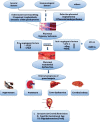Biomarkers for the management of pre-eclampsia in pregnant women
- PMID: 24056556
- PMCID: PMC3767267
Biomarkers for the management of pre-eclampsia in pregnant women
Abstract
Pre-eclampsia (PE) is a pregnancy related disorder characterized by hypertension and proteinuria noticeable after 20 wk of gestation. It is a leading cause of maternal and foetal mortality and morbidity worldwide. The aetiology of the disease is unknown, but recent studies have revealed that this disorder appears to originate in placenta and is characterized by widespread maternal endothelial dysfunction. Till date, delivery of placenta is the only cure for the disease. So, there is a need for the identification of highly specific and sensitive biochemical markers that would allow early identification of patients at risk and thus help in providing proper prenatal care. Several promising biomarkers have been proposed, alone or in combination, that may help in predicting women who are likely to develop PE. Maternal serum concentrations of these biomarkers either increase or decrease in PE during gestation. This review focuses on the various biomarkers available and their utility in predicting pre-eclampsia.
Figures
Similar articles
-
Biomarkers in pre-eclampsia: a novel approach to early detection of the disease.J Obstet Gynaecol. 2012 Oct;32(7):609-16. doi: 10.3109/01443615.2012.709290. J Obstet Gynaecol. 2012. PMID: 22943702 Review.
-
The use of angiogenic biomarkers in maternal blood to identify which SGA fetuses will require a preterm delivery and mothers who will develop pre-eclampsia.J Matern Fetal Neonatal Med. 2016;29(8):1214-28. doi: 10.3109/14767058.2015.1048431. J Matern Fetal Neonatal Med. 2016. PMID: 26303962 Free PMC article.
-
Endoglin, PlGF and sFlt-1 as markers for predicting pre-eclampsia.Acta Obstet Gynecol Scand. 2008;87(8):837-42. doi: 10.1080/00016340802253759. Acta Obstet Gynecol Scand. 2008. PMID: 18607829 Clinical Trial.
-
Emerging new biomarkers of preeclampsia.Adv Chronic Kidney Dis. 2013 May;20(3):271-9. doi: 10.1053/j.ackd.2013.01.001. Adv Chronic Kidney Dis. 2013. PMID: 23928393 Review.
-
Uterine artery Doppler and biochemical markers (PAPP-A, PIGF, sFlt-1, P-selectin, NGAL) at 11 + 0 to 13 + 6 weeks in the prediction of late (> 34 weeks) pre-eclampsia.Prenat Diagn. 2011 Dec;31(12):1141-6. doi: 10.1002/pd.2848. Epub 2011 Oct 28. Prenat Diagn. 2011. PMID: 22034048 Clinical Trial.
Cited by
-
Increase in Ischemia-Modified Albumin and Pregnancy-Associated Plasma Protein-A in COVID-19 Patients.J Clin Med. 2021 Nov 23;10(23):5474. doi: 10.3390/jcm10235474. J Clin Med. 2021. PMID: 34884175 Free PMC article.
-
An analysis of the risk factors of preeclampsia and prediction based on combined biochemical indexes.Kaohsiung J Med Sci. 2018 Feb;34(2):109-112. doi: 10.1016/j.kjms.2017.10.001. Epub 2017 Nov 6. Kaohsiung J Med Sci. 2018. PMID: 29413226 Free PMC article.
-
Are the blood groups of women with preeclampsia a risk factor for the development of hypertension postpartum?Ther Clin Risk Manag. 2016 Apr 19;12:617-22. doi: 10.2147/TCRM.S100557. eCollection 2016. Ther Clin Risk Manag. 2016. PMID: 27143904 Free PMC article.
-
First- and Second-Trimester Uterine Artery Doppler and Hypertensive Disorders in Twin Pregnancies.J Clin Med. 2025 Aug 7;14(15):5563. doi: 10.3390/jcm14155563. J Clin Med. 2025. PMID: 40807184 Free PMC article.
-
Towards molecular mechanisms regulating the expression of galectins in cancer cells under microenvironmental stress conditions.Cell Mol Life Sci. 2015 Nov;72(22):4327-40. doi: 10.1007/s00018-015-2008-x. Epub 2015 Aug 6. Cell Mol Life Sci. 2015. PMID: 26245305 Free PMC article. Review.
References
-
- Haig D. Genetic conflicts in human pregnancy. Q Rev Biol. 1993;68:495–532. - PubMed
-
- Noronha Neto C, de Souza AS, Amorim MM. Pre-eclampsia treatment according to scientific evidence. Rev Bras Ginecol Obstet. 2010;32:459–68. - PubMed
-
- Arora R, Ganguli RP, Swain S, Oumachigui A, Rajaram P. Determinants of maternal mortality in eclampsia in India. Aust N Z J Obstet Gynaecol. 1994;34:537–9.
Publication types
MeSH terms
Substances
LinkOut - more resources
Full Text Sources
Other Literature Sources
Miscellaneous

